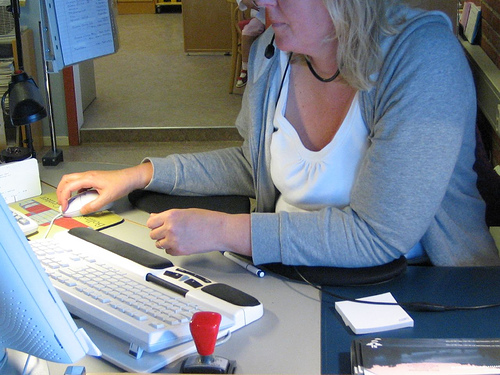The modern office setting has evolved over the decades. We’ve seen everything from enclosed offices for everyone to the open office designs of the 1950s to today’s cubicle farms. Along the way, we’ve seen changes in the way office furniture and office equipment is designed, too.
What does all of this have to do with pain at work? One of the most common reasons people experience chronic pain and discomfort at work is because of poor office design. The science of ergonomics – fitting the setting to the body’s natural proclivities – is simply often ignored in the modern office setting.
Here are some of the more common office realities that can cause chronic pain, and some ideas about how to handle them:
- Your screen is too high or too low. The position of your computer screen is one of the most important factors in how your body responds to your work environment. Ideally, you should be able to look straight ahead and peer just over the top of your computer screen. This minimizes straining on the neck while you look at your screen. You’ll also want to deal with any glare on the screen, as this will often cause you to unnecessarily adjust your neck and body position in order to try to see what you need to see.
- Lack of lumbar support. Your office chair needs to provide lumbar support. This keeps your body aligned while you’re sitting at your desk, and prevents unnecessary lower back strain. If your office chair doesn’t have lumbar support and if you can’t convince your employer to get you one that does, sometimes a small pillow behind your lumbar region can do the trick. Over the long term, however, the best solution is a chair that offers the support you need.
- Incorrect arm and wrist position. Today’s office jobs have made carpal tunnel syndrome a household phenomenon. Repetitive stress injuries are especially common in the forearms and wrists. To avoid these kinds of work-related pains, you’re going to need to keep your forearms straight while working. You’ll need your wrists and your elbows to be at the same level, which will go a long way toward avoiding carpal tunnel syndrome and other repetitive stress injuries.
- Repetitive tasks. Repetitive task injuries are common in office workers as well as in other types of workers. In some cases, it’s simply a matter of varying your routine or approach to a task enough so that you can give the muscles and joints you normally use a bit of a break. In other cases, however, it’s not so easy. If your job involves repetitive tasks that are causing you aches and pains, talk to your boss or your HR department. It may be possible to reconfigure your work environment, change some of the task’s processes, of even shift your responsibilities in that task across a number of other people, allowing you to engage in something else for a while each day.
- You’re stuck to your chair. Some jobs – for example, telephone customer service – don’t require much from you physically. In fact, they require you to not be physically active. They require you to sit in a chair in relatively the same position for hours on end. It’s no wonder you’re stiff and sore at the end of the day. To cope with these kinds of aches and pains, make sure to take some time each day to move around. When you have a break, don’t sit at your desk. Walk around the office, or go outside for a few minutes and get some fresh air. Even doing some basic leg stretches and hand grasps during the work day can relieve some of that pain.
- You can’t look away from your computer. Reading and working at a computer for extended periods of time can lead to eyestrain. Eyestrain manifests itself in pain in the eyes. They may also itch or burn, and can occasionally lead to blurred or double vision. Eye strain often goes away after a while, but if it doesn’t it’s usually indicative of a different eye condition. Wearing glasses designed for computer use can, in some cases, alleviate eyestrain.
Your job soaks up much of your time; don’t let it soak up your health, as well. Consider these potential causes of workplace pain, and take steps along with your employer to address them today.



_9_2_1-250x220.jpg)






